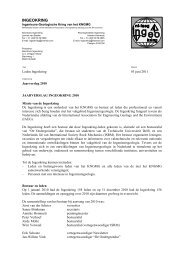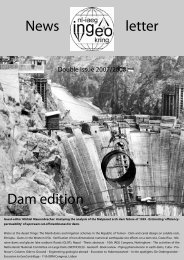environment
environment
environment
- No tags were found...
Create successful ePaper yourself
Turn your PDF publications into a flip-book with our unique Google optimized e-Paper software.
Vol. 11 No. 1 2004<br />
the cone. Decreasing the confining pressure result in,<br />
besides a decrease of the cone penetration resistance,<br />
large differences in size of the area affected and degree<br />
of density changes. A larger difference is observed by<br />
lowering the sand density. The size of the area dilating<br />
is significantly smaller and the degree of dilation is much<br />
lower. The use of rigid boundaries only resulted in a<br />
small decrease of the dilating area.<br />
It was not possible to observe shear bands in the sand<br />
sample with the CT- scanner setup present in the Faculty<br />
of applied Earth science of the Technical University in<br />
Delft. Reasons for this are the not perfect homogeneity<br />
of the sand samples and the noise in the CT-scanner.<br />
Abstract thesis Sabine<br />
Backx<br />
TU Delft<br />
Investigation of practical use of synthetic and mixed<br />
arrays in 2D resistivity surveys and the optimization<br />
of acquisition configurations<br />
The last decades shallow depth geophysics are<br />
becoming more used for engineering geological<br />
purposes. One of the used methods is the direct current<br />
(DC) resistivity method. Lately, multielectrode systems<br />
have become more user friendly thanks to increasing<br />
computer power. But the fieldwork necessary for data<br />
acquisition is still a very time consuming job. To minimize<br />
this amount of work, synthetic electrode arrays can be<br />
very useful.<br />
The goals of this research are twofold: The first is to<br />
consider the feasibility of synthetic electrode arrays<br />
created out of the pole-pole configuration from the geoelectrical<br />
method. The second goal is to find out if mixed<br />
arrays with these synthetic data would lead to better<br />
results with a better resolution and benefits from all the<br />
different configurations compared to one single<br />
measurement.<br />
For most common arrays, with the aid of four different<br />
models, that represent different possible geological<br />
features, the conversion from pole-pole to synthetic<br />
data is investigated. Every model has three different<br />
options, resembling different resistivity distributions.<br />
So boundaries going from high to low resistivity and<br />
the other way around. It shows that the conversion<br />
into other common arrays is useful, since an increase in<br />
data points, and therefore an increase in resolution<br />
appears. Even when the accuracy limits of the later used<br />
apparatus were taken into account the results were still<br />
very good.<br />
For the same models mixed arrays were created. In this<br />
research, mixed arrays are arrays that consist out of<br />
both the pole-pole data set and the synthetic common<br />
array data set. They are placed in one data file and<br />
inverted simultaneously. The results give a good level<br />
of detail for the shallow part, but also have the benefits<br />
of the large depth that the pole-pole array can achieve.<br />
The mixed arrays show at deeper parts even a lower<br />
sensitivity to resistivity changes than the pole-pole<br />
array. Apparently the software uses more information<br />
when it is not being told what type of array is used.<br />
Accuracy plots are produced by comparing the inversion<br />
results of all the different arrays with the original models.<br />
The relative difference between these points is plotted<br />
in graphs. These show that the singular arrays have an<br />
enormous oscillating pattern where the mixed arrays<br />
show a more constant deviation. The accuracy graphs<br />
show for every array an increase in deviation when<br />
approaching the boundaries of the model. This is due<br />
to the absence of data beyond the boundaries.<br />
A field survey has been conducted to check the<br />
modeling results with the real life data. Four different<br />
lines were being measured. One to check the<br />
repeatability of testing when the stakes remain in the<br />
ground over night. A second line was used to see if a<br />
limited distance of the far away electrodes would<br />
influence the data. Both lines gave a positive response<br />
in the sense that there were no influences visible from<br />
both actions.<br />
The last two lines were the actual lines used for the<br />
research purpose. One line used 48 electrodes and was<br />
measured with pole-pole, pole-dipole, dipole-dipole and<br />
schlumberger. The 72-electrode line was only measured<br />
with pole-pole, pole-dipole and schlumberger. Both lines<br />
have been measured with different arrays while the<br />
stakes remained in the ground, to ensure an exact<br />
positioning. The pole-pole data was converted into<br />
synthetic data and this synthetic data set could then be<br />
compared to the original measured arrays. The synthetic<br />
data sets showed an increase in data points and<br />
therefore resolution. Even when taking into account<br />
the limitations of the apparatus, and minimizing the<br />
amount of significant numbers possible, the subsurface<br />
image that was produced was still very useful. Of course,<br />
the conversion only works with a good pole-pole data<br />
set, so it is possible that this data set has to be edited<br />
before it is ready for conversion.<br />
Extra points for further research are the expansion into<br />
3 dimensions, better software and an extended field<br />
survey.<br />
63




